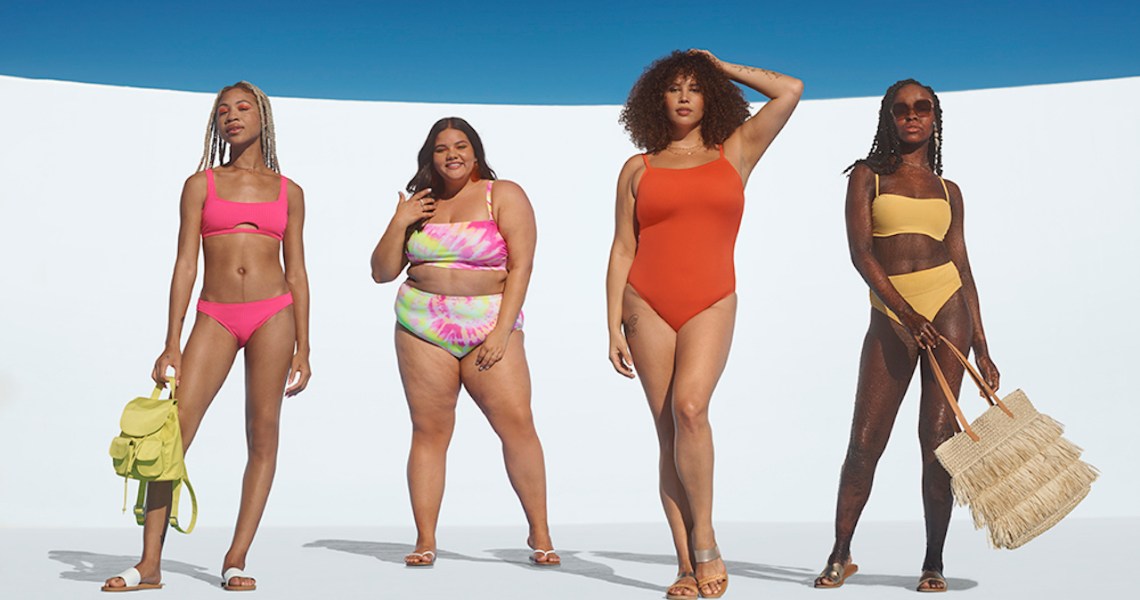With Instagram becoming increasingly saturated with new swimwear brands and more digital natives moving into the market, Target is still managing to forge ahead in the category, thanks largely to its private-label brands.
Last week, Target launched its largest swimwear collection to date, with over 1,800 women’s styles. According to the retailer and The NPD Group, Target has been the No. 1 men’s and women’s swimwear retailer in the U.S., based on sales, above both mass and speciality retailers, since 2015. The company does not break out swim sales, but it shared in its 2018 annual report that apparel and accessories accounted for 20% of the companies $74.4 billion in sales for the year.
Target’s triumph in this category (as well as the influx of DTC swim companies) seemed to kick-start with the decline of Victoria’s Secret’s swimwear business. In 2016, Victoria’s Secret exited the bathing suit business, fleeing a category it once dominated. At one point, swim made up 6.5% of the company’s sales and was a $500 million business. In March 2019, Victoria’s Secret relaunched swim after a three-year break, but it didn’t do much to wow consumers and analysts.
In 2019, U.S. swimwear became a $5 billion market, according to market research provider Euromonitor International. Digital-first companies are looking to take a big chunk of that. Those companies could pose a threat to Target in the coming years; however, many are sold at a higher price point. Many buzzy DTC brands sell suits for around $100, while Target’s average price is around $40.
In the last few years, brands from Andie Swim to Summersalt have gained big followings. After launching in 2016, Andie Swim has sold out of its inventory 10 times, amassed waitlists of over 10,000 for some styles and gained 67,400 Instagram followers. The company does not share sales figures. Summersalt launched in 2017, and now has 142,000 followers. Summersalt also does not disclose revenue, but it has raised $26.7 million in funding to date and has expanded beyond swimwear into sleepwear, “travelwear” and loungewear.
“The landscape is competitive, and there will likely be some overlap between those shopping and considering shopping at Target for swim and those who are interested in the DTC brands, but Target also benefits from having multiple types of customers. That includes city dwellers in its city stores and suburban moms who are already shopping there for other household needs,” said Alexis DeSalva, senior analyst for retail and e-commerce at Mintel. “To compete with the Instagram brands, Target should focus on building awareness of its swimwear on social and leverage the platforms as a way to [use] customers’ feedback.”
Currently, target’s swim styles are based on swim and fashion trends, including feminine details, snake prints, texture and solids. Target’s wide range of styles differs from the typical DTC strategy. Most competitors are focused on streamlining offerings with solid colors or minimal prints in a quest to offer the perfect swimsuit.
Ad position: web_incontent_pos1
“There can be too much of a good thing, and while variety is appreciated, Target needs to carefully monitor how many varieties it offers, and carefully manage the availability between stores and online in order to avoid having too much inventory,” said DeSalva.
The collection includes 400 one-piece suits, 550 bottoms, 800 tops and 80 cover-ups across five of the retailer’s owned brands, including the newest, activewear line All in Motion, which rolled out earlier this month. Most of the women’s collection covers sizes XS-XL, with some styles available in sizes 14-26. Styles have already rolled out online, with more to come leading into spring and summer.
Like many other categories within Target, private-label brands dominates the selection. All in Motion has a line of sporty, active suits, Kona Sol covers more feminine styles, Xhilaration features on-trend pieces, Shade & Shore features bra-size suits (32A-38DDD), and Aqua Green covers classic styles. The selection also includes some brands exclusive to Target, like Sea Angel Swim.
For the 2020 campaign, the retailer once again focused on inclusive messages in its marketing. There was no retouching of the images, which featured models of all different sizes. Target is promoting the launch across social media, with paid and organic posts across Facebook, Instagram and Twitter.
Online, the company is trying something new for 2020 that several companies in the plus-size space (like Universal Standard) have already perfected: showing all styles on models of various sizes. For Target, it’s meant to “further solidify [its] stance on inclusivity,” said Courtney Foster, a spokesperson for Target.




